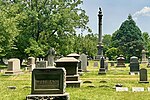Isaac Watson House

The Isaac Watson House is the headquarters of the New Jersey State Society of the National Society of the Daughters of the American Revolution (DAR). It is located just outside the state capital of Trenton in Hamilton Township, Mercer County, New Jersey. It is situated on a bluff overlooking Watson's Creek and the Abbott Farm National Historic Landmark in John A. Roebling Park, a 257-acre nature preserve.Built by Isaac Watson in 1708, the stone house is recognized as the oldest house in Mercer County. Originally 800 acres, the grounds at one time ran from the bluff to the Delaware River.The building was restored by the DAR as part of the New Jersey Tercentenary Celebration in 1964 and listed on the New Jersey Register of Historic Places in 1972 and the National Register of Historic Places on January 21, 1974.
Excerpt from the Wikipedia article Isaac Watson House (License: CC BY-SA 3.0, Authors, Images).Isaac Watson House
Wedge Drive,
Geographical coordinates (GPS) Address Nearby Places Show on map
Geographical coordinates (GPS)
| Latitude | Longitude |
|---|---|
| N 40.190555555556 ° | E -74.727222222222 ° |
Address
Wedge Drive
08610
New Jersey, United States
Open on Google Maps






